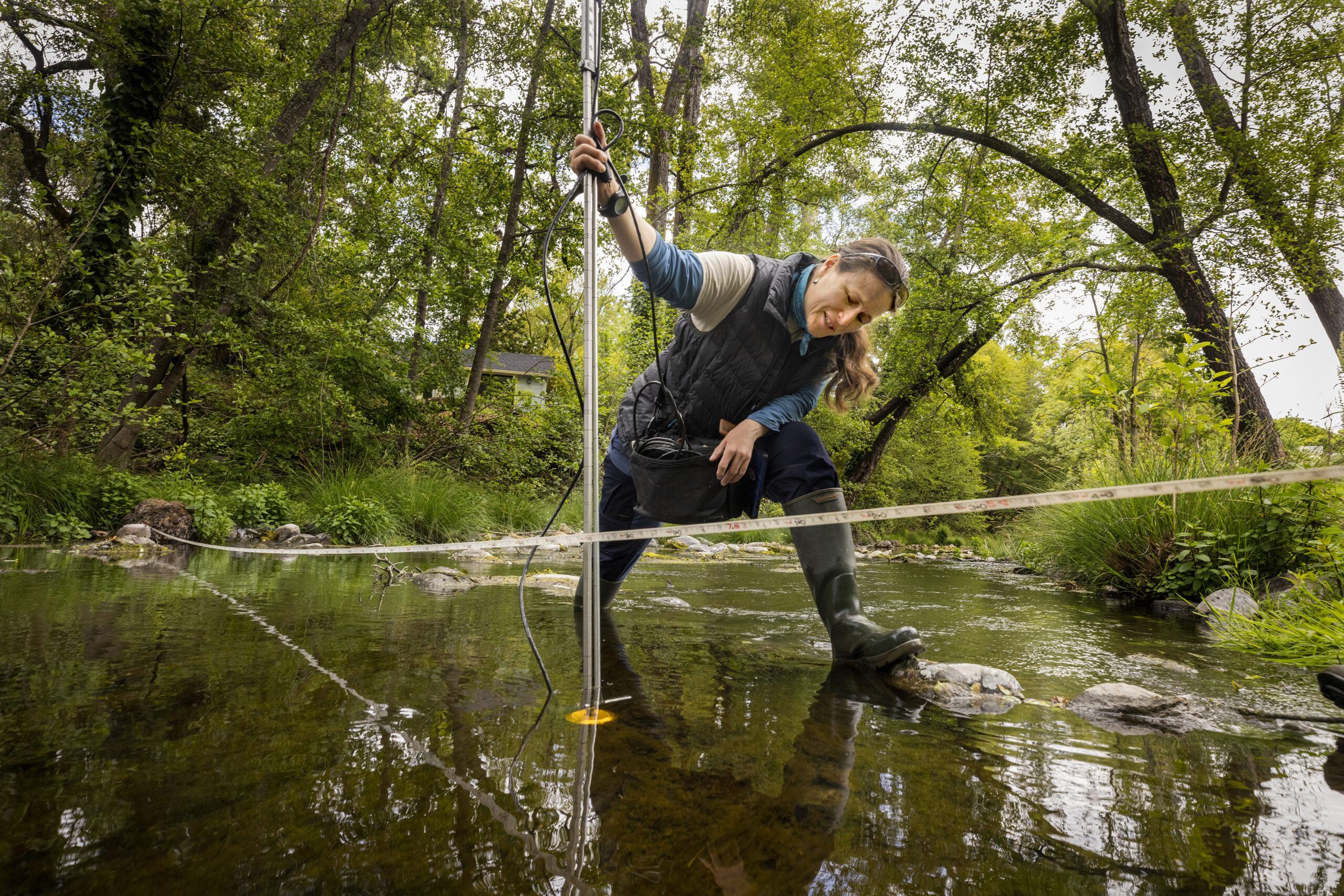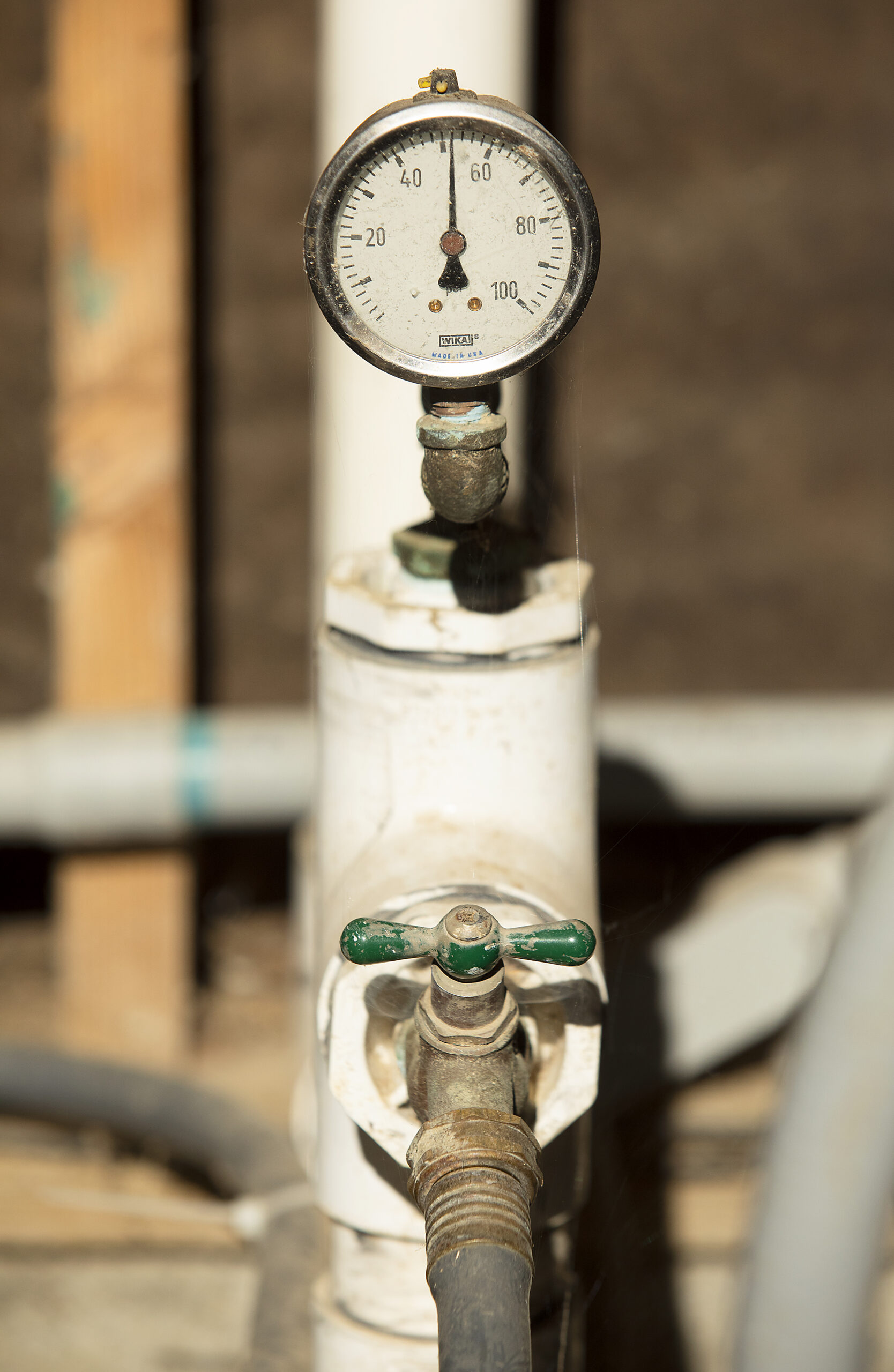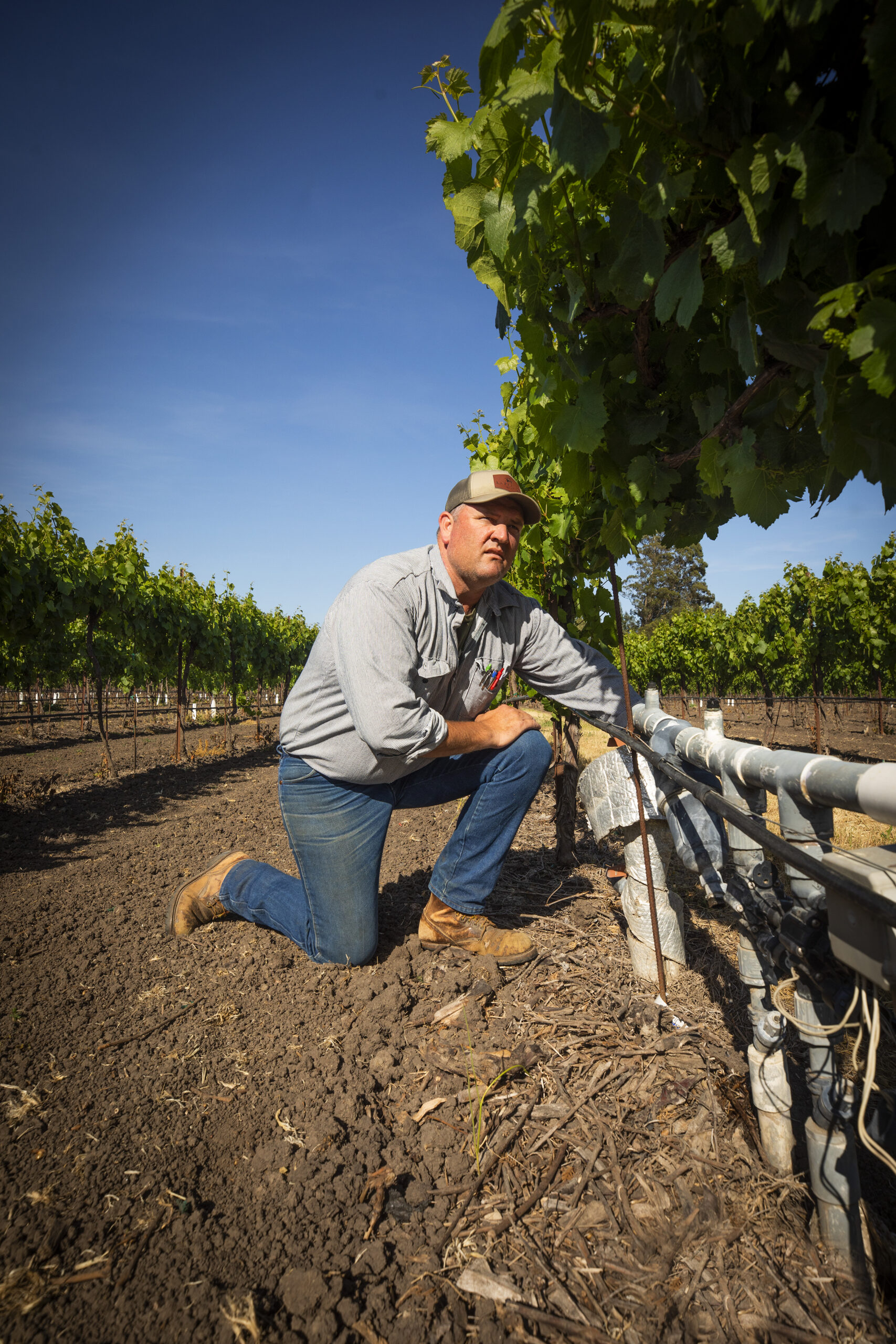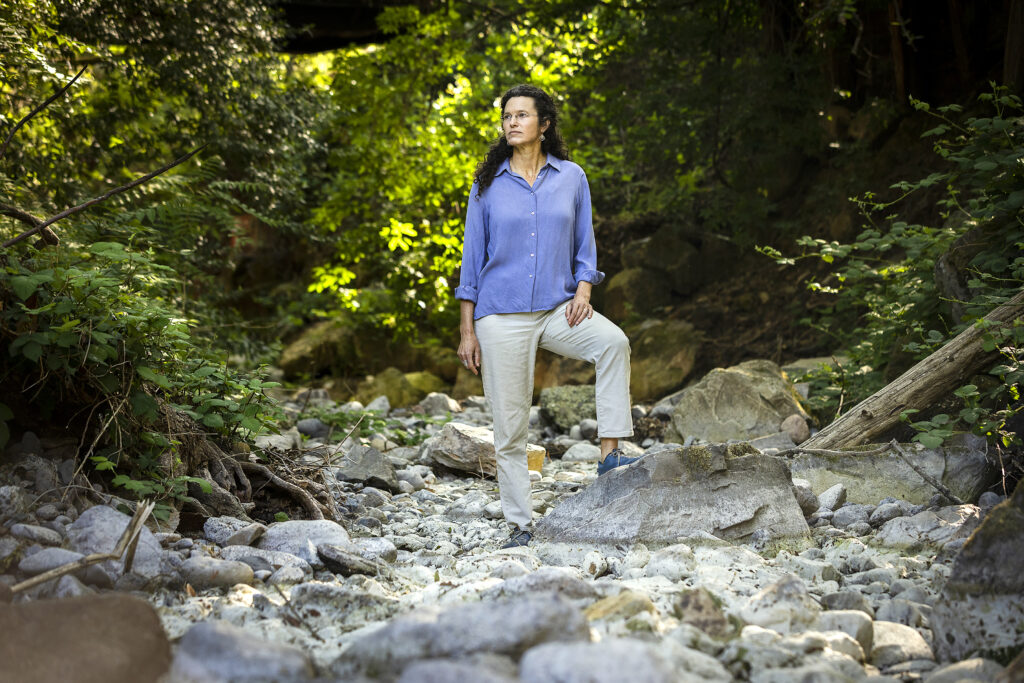Residents of Sonoma Valley are on the front lines of a reckoning with new regulations to manage the state’s well water. But even in a community that prides itself on sustainability, the long-term path to a healthy aquifer is full of challenges.
One morning in the summer of 2018, Kelly Stober woke up and started to get ready for work. But when she turned on the faucet in her shower, no water came out.
Stober lives in a rural neighborhood a few miles east of downtown Sonoma. Like her neighbors, she relies on a well for drinking water, household uses, and irrigation. And her well, sunk 800 feet into the ground, had run dry.
It was a startling revelation about an unseen and scarce resource. Groundwater runs deep below the Earth’s surface, stored in the cracks between soil and rock, collecting slowly over eons in aquifers that resemble a layer cake.
Experts, though, are fond of another metaphor to depict how that finite resource is at risk of exploitation. They liken groundwater held in aquifers to a big milkshake, with each well a straw. The more straws, the less milkshake to go around.
Sonoma County has among the highest concentration of those straws in California–up to 45,000 registered wells. And Sonoma Valley, one of the world’s prized winemaking regions and home to some 41,000 people from Kenwood to Schellville, has long been singled out as the local area most at risk of depletion.
At the southern end, near San Pablo Bay, saltwater intrusion—the underground creep of brackish water into freshwater stores—has long been a key concern. But the alarms grew last summer as Sonoma Valley’s aquifer showed declines of 15-20 feet in places. That deficit, after another winter of lackluster rains, is part of a long-term pattern of aquifer depletion, fueled by unchecked pumping for irrigation, homes, and other purposes.
Now, amid California’s worst drought in over four decades–and the most pronounced arid streak in the western U.S. in 1,200 years–more of the valley’s wells are turning up dry, say residents and officials who represent the area.
That has heightened fears for residents like Stober and presented new challenges for the region’s winemakers and elected officials, making Sonoma Valley a microcosm of the wider drought-plagued West. The questions being raised here, among neighbors and farmers, government panels and private industry, could have wide ranging implications for the future of development and agriculture in a place that cherishes its rural identity.
The stakes have only grown in the face of new state-mandated regulations that require local commissions to study groundwater use and develop plans to ensure sustainable groundwater supplies in their communities.
“People are being dragged kicking and screaming into having to regulate something that’s been unregulated so far,” says Fred Allebach, a Sonoma Valley resident who leads an advisory panel helping to implement a local plan for groundwater regulation. “There might have to be some limits. I think that’s just a fact in a world of finite resources and a growing population— we have to deal with that.”
Supervisor Susan Gorin, who has represented the valley on the Board of Supervisors for a decade, suggested something drastic may be needed: Halting approvals for new wells entirely.
“Maybe it’s time to stop, take a pause and say, ‘No more wells in our basin until groundwater starts to recover,’” says Gorin, offering up the idea of a moratorium in a May interview. At the very least, she says, “it’s about time that we get serious about more requirements: where the wells are located and the impact they might be having on neighboring wells.”
People are being dragged kicking and screaming into having to regulate something that’s been unregulated so far. There might have to be some limits. I think that’s just a fact in a world of finite resources and a growing population—we have to deal with that.
–Fred Allebach, Chair of the Groundwater Advisory Committee in Sonoma Valley
Sonoma Valley is one of three groundwater basins in Sonoma County—the others are in Petaluma and along the Santa Rosa Plain. Of the three, the 44,000-acre Sonoma Valley basin, with an estimated 900-1,250 domestic wells, is the only one classified by the state as “high priority,” due to the degree of the valley’s dependence on groundwater supplies, its population, and other factors.
But the valley is unique in that it began piloting voluntary groundwater management as far back as 2007, after a study demonstrated signs of aquifer depletion due to overpumping.
“Sonoma Valley was very much the pioneer for the other basins in Sonoma County,” says Caitlin Cornwall, vice chair of the committee advising the Sonoma Valley on its groundwater plan and a senior project manager at Sonoma Ecology Center.


Across the state, there are far worse cases of groundwater overuse, and more protracted fights over how to resolve it. South of Stockton, the vast San Joaquin Valley, with some of the nation’s most prosperous farmland, serves as one cautionary tale. Years of overextraction have caused land to sink in some places by as much as 30 feet.
Climate change has posed new threats, too, and not just to groundwater supply. During a drought, the concentration of pathogens and other contaminants in drinking water can increase. Heavier rains, floods and mudslides also impact water quality, and fires can damage well systems, leaching toxic chemicals and leading to costly repairs.
California’s response to those alarming trends was to turn a century and a half of hands-off groundwater management on its head. Under a 2014 law seen as then-Gov. Jerry Brown’s most aggressive move against the drought during his tenure, well water use will be regulated and monitored going forward, part of a new framework of government intervention meant to stabilize underground water levels in the state’s 515 groundwater basins within two decades.
“California was, famously, the last state in the West to adopt a state-level requirement for management,” says Ellen Hanak, vice president and director of the PPIC Water Policy Center and a senior fellow at the Public Policy Institute of California. “That said, our law is a lot more comprehensive … We’re starting late, but it’s kind of a nice law in allowing for a lot of local determination of how folks are actually going to do this, but with a backstop”—the state—that’s “actually got teeth.”
The ‘local’ involvement comes in the form of over 260 new public entities, known by the unwieldy common moniker Groundwater Sustainability Agencies, or GSAs. The appointed bodies, each managed locally, are tasked with ensuring the health of the state’s most endangered groundwater basins, including Sonoma Valley. Sonoma Valley’s GSA includes a board of directors representing local water agencies and county government, as well as an advisory committee representing a gamut of interests, including farmers, rural residents, and the environment.
“The GSA’s job is to make sure that there’s still some milkshake there for everybody in the future,” says Allebach, who chairs the Sonoma Valley groundwater agency’s advisory committee.
Critically, however, there is no built-in state financial support for implementing the plans each agency needs to craft. They must find that funding mechanism, a politically fraught task that could result in annual fees never before paid by well users. Elected officials are scrambling to delay that scenario, at least for rural residents, and pony up taxand ratepayer money that would temporarily cover the cost of groundwater management.
But it is likely that one way or another, well owners—residents, farmers, and business owners—will eventually foot the bill.

The water level in Kelly Stober’s rural Sonoma well had been dropping for years by the time it ran dry in late summer of 2018. She was forced to have water delivered by truck as much as twice a week, each delivery costing $250. The following year, despite a long wait list for well drilling—a result of high demand—she had a second 500-foot well installed, at a cost of $65,000. She also installed a system to monitor leaks, pump rates, and water levels.
For the moment, her well is stable. It provides enough water for about two acres of landscaping, with a hundred olive trees, a garden, and some rosebushes. Strober has already removed half her lawn and uses drought tolerant native plants when possible. “We try to be conscientious about our water use,” she says.
Data on the viability of Sonoma Valley’s domestic wells is hard to come by, but Stober’s experience is likely not a rare one. Supervisor Gorin, who lives in a Santa Rosa subdivision at the northern end of Sonoma Valley, says “we know anecdotally that wells are drying up. Residents are having to drill deeper wells at great expense, and when they do drill, they are not finding the water availability.”
Stober is very concerned, as are many other rural residents, about the idea that she might soon be paying money to pump water from her wells. Under the current proposed regulatory fee, residential well owners in the valley’s management zone would pay a flat rate between $48-$80 per year.
Like other local groundwater agencies across the state, Sonoma County’s proposals have included various options: a parcel tax, per-well fees, regulatory fees, and a benefit assessment district, which would require voter approval. But some of the proposed fee rates in the three Sonoma groundwater basins differ widely. In Petaluma, the most sparsely populated basin, for example, some fee options are significantly higher per household, because there are fewer residents to share the cost.
So who carries the burden? And who decides what’s fair?
Some residential well owners like Stober wonder whether additional fees put undue strain on them, pointing to the high cost of well maintenance that they already pay. The $65,000 Stober spent on her second well, she says, doesn’t count the ongoing costs of labor and maintenance.
Many Sonoma Valley residents have voiced concern the proposed fees are just a baseline and may go up, particularly if large-scale aquifer restoration projects are needed in the future. “What I saw proposed didn’t seem like a very high amount,” says Schellville resident Terry Crisler, who needed to drill a new well at her home in November of 2020. “My concern is, what’s the next step?”
But rising fees are not a foregone conclusion, says Sonoma Valley’s groundwater agency administrator Ann DuBay, a longtime spokesperson for Sonoma Water, the county’s main drinking water supplier. The current fees will fund monitoring, data collection, and planning for five years. After that, specific groundwater projects may need additional funding, but that money could come from grants, member agencies, or from well owners. That’s a decision for the next rate and fee study, she says.
“We don’t own the water; we understand that,” says Stober. “We need to come up with a plan.” But, she says, it needs to be fair.
It’s like a prisoner’s dilemma. If somebody thinks someone else is cheating, then they won’t cooperate–and so then everybody loses.” –Fred Allebach
What seems fair to many policymakers is to require those who use the most groundwater—mainly farmers—to pay in a way that covers their majority share of the milkshake.
But Taylor Serres, a sixth-generation wine grape farmer and appointee to the advisory panel for Sonoma Valley’s groundwater agency, argues that adding another financial burden for farmers already operating on tight margins is too much of a strain. She contends that step poses serious risks to the viability of agricultural operations and the rural character of the valley. “There are a lot of extremely unhappy people, both residential and in agriculture,” Serres says.
Supervisor Gorin believes the costs of managing the valley’s groundwater should not be borne entirely by urban residential users—nor entirely by agricultural or rural residential users either. “But for those water users above two acre-feet per year, they have an obligation, a moral obligation, to be part of the community that safeguards the basin,” she says.
Ultimately, says the PPIC Water Policy Center’s Ellen Hanak, the problem is straightforward. “Agriculture is the biggest user,” she says, “and if they’re not paying, then someone’s subsidizing them. It comes down to this question: Who is willing to subsidize ag?”
There don’t appear to be a lot of volunteers, and that’s not just in Sonoma, says Hanak.
Across California, local groundwater agencies have been wrestling with how to assign fees in a way that doesn’t place undue burdens on any one group of users. An in-depth academic study of the first five years of the state law’s implementation across California found the most common obstacles agencies face across the board are lack of trust and divergent interests among stakeholders.
“It’s like a prisoner’s dilemma,” says Allebach, who rents a home on a property where the well went dry for several months in 2005. “If somebody thinks someone else is cheating, then they won’t cooperate—and so then everybody loses.”

Just how much of the milkshake do Sonoma Valley farmers use? And how would that translate to fees?
There isn’t data available yet to say for certain about use, but roughly 44% of Sonoma Valley land is under active cultivation. Vineyards are the largest water users, relying not just on groundwater but surface water impounded from streams and runoff into ponds, along with recycled water. (Cannabis, a water-intensive crop, is currently not widely grown enough in the valley to have a significant impact on groundwater, county officials say.)
Most farmers have known for a long time that they’d have to pay for water eventually, says Mike Sangiacomo, a third generation grapegrower and board vice chair of the Sonoma Valley groundwater agency. “Agriculture in general knows that they could potentially carry the lion’s share of the fees,” he says. “We just don’t want to carry it all.”
Ned Hill, the owner o f La Prenda Vineyards Management, agrees. “Every year, there are more regulatory burdens,” he says. At the same time, having been born and raised in the valley, he acknowledges the vital importance of managing groundwater: “You’d be sticking your head in the sand to say that it’s not an issue.”
“You’d be sticking your head in the sand to say that it’s not an issue.” – Vineyard Manager Ned Hill
Hill wonders, however, whether policymakers are unfairly penalizing farmers, when homeowners could pay lower rates to maintain a green lawn, for example. “If you’ve got 20 rose bushes, I’m using more water than you are,” he says. “I can’t argue with that. But an acre of grapes is going to use less water than an acre of lawn.”
Stober, who works in real estate, says residents can’t deny that one of the reasons Sonoma Valley is so desirable is because of the vineyards. “So if you start penalizing them, like making them pay for their water— that affects Sonoma County overall.” If vineyards can’t be successful here, she says, “then what are we going to do?”
Caitlin Cornwall echoes her point. If groundwater becomes a limiting factor for viticulture—either because of cost or due to depletion—that land could be put to other uses. “We could see that land abandoned, homes being built, or something else we can’t imagine yet. It’s not a future that anyone wants.”
Sonoma Valley’s long-term housing trends are another unknown factor in the debate over how to balance demands on groundwater. Both Hill and Stober say they’ve seen an influx of new residents in their neighborhoods. Sonoma Valley has gained more part-time residents and more vacation rentals, too, reflecting a pattern that’s playing out in the most sought-after corners of Wine County.
Housing, meanwhile, remains in short supply for middle and working-class families, posing another dilemma with implications for groundwater: More development means less surface area for rain to be absorbed into open ground, reducing the recharge needed to replenish aquifers.
The development tradeoff doesn’t get much mention in public disputes about new construction.
But, Ned Hill points out, “You can’t have it both ways.”
Though the pace of residential growth in Sonoma Valley was dealt a major setback by fires since 2017, it remains a major factor in the long term, with a key underlying question: How many wells can the basin sustainably support?
Supervisor Gorin hinted at that overarching issue when she indicated support for study of a short-term ban on new wells—a possibility that the Board of Supervisors has yet to discuss. At the very least, following a 2021 executive order from Gov. Gavin Newsom, the Sonoma Valley groundwater committee is likely to begin involving itself in a more rigorous permitting process for new commercial and agricultural wells.
Acknowledging that the issue may be politically fraught, Gorin says, “Nothing about this is easy.”
For Cornwall, a well moratorium isn’t the answer. The real issue, she says, is not the number of wells, but total water use across the basin. To address that, she points to a groundwater trading model, which caps total groundwater use, but allows water users to buy and sell water allotments, not unlike the state’s credit system for carbon emissions.
Advocates say the model incentivizes conservation and while allowing for individual flexibility. But the idea is still very new: water agency managers in Ventura County launched the state’s only groundwater trading model just two years ago.
In Sonoma Valley, where the groundwater agency is still focused on implementing and funding its initial sustainability plan, any serious consideration of such a novel program is still a long way off. But, says Ann DuBay, the groundwater agency’s administrator, it’s an intriguing possibility, even as residents’ sense of urgency increases.
“Last summer we saw what happens in a drought without resources to protect groundwater,” says Cornwall. “The drought continues. Delaying action will only make things worse. It’s going to take a funded GSA to reverse the alarming trend that we’re in.”
We’d like to see a future with abundant groundwater, abundant stream flow, oak groves that are going to be able to find water even in a multi-year drought.” – Caitlin Cornwall
With some of the biggest questions still unresolved, Sonoma Valley’s groundwater officials are set to vote this summer on a stopgap measure: a temporary fee for one year, based on groundwater usage and a minimal agency budget. If that compromise stalls, the program will continue to tap funds from participating public agencies, including the city of Sonoma, in effect subsidizing the cost of groundwater regulation from a wider pool of city residents.
The continued struggles, now more than seven years into the new era launched by California’s Sustainable Groundwater Management Act, illustrate the political challenges inherent in marshaling support for government action that too few stakeholders see as a direct benefit.
That perspective often gets lost in the tug-of-war over fees, says Cornwall, who sides with those contending that groundwater management, while costly, also offers long-term assurances for every resident in the valley. “It means well owners won’t have to spend hundreds of thousands of dollars deepening their wells. It means they won’t see their wells depleted by neighboring agricultural wells. It means that the water suppliers— the city of Sonoma and Valley of the Moon Water District—also won’t have to deepen their wells and pass those costs onto their customers. It means that we won’t have to worry about the land sinking. It means that the wells near the southern part of the valley will keep pumping fresh water—and the quality of their water could improve.”
Board members agree there’s a need to better articulate these benefits to those leery of rising costs. Even so, some are wondering if and when the finger-pointing —homeowners vs. grapegrowers, vineyards vs. cannabis operations, new residents vs. longtime ones—will end.
Fred Allebach, the advisory committee chair for the valley’s groundwater agency, says those interests should focus on cooperation, “rather than have it be a circular firing squad.”
Others are more hopeful that constituent groups will be able to work together. They emphasize that with the state law’s requirements laid out in no uncertain terms, there’s really no alternative. “The goal,” says Mike Sangiacomo, is “an equitable and sustainable solution both for the groundwater and for everybody’s businesses and livelihoods.”
“What we pull off here can offer lessons to a lot of other groundwater basins around the state,” agrees Cornwall. “We’d like to see a future with abundant groundwater, abundant stream flow, oak groves that are going to be able to find water even in a multi-year drought. We see benefits to people and to nature. Higher groundwater levels are worth aiming for.”
“Up to this point, we have all thought that it was free, that this was our private water source. But aquifers are the great connector,” says Gorin. The question now, she says, is: “What is right, what is fair, and what is equitable to safeguard the common aquifer that we need?”

Groundwater By the Numbers
40%
Amount of California’s water supplied by underground aquifers in a year of normal rainfall
60%
Amount supplied by underground aquifers in a drought year
15-20 feet
The decline in the level of certain sections of Sonoma Valley’s deep aquifer in 2021, a result of extreme drought combined with unchecked pumping
900-1,250
The estimated number of domestic wells in Sonoma Valley
2,000
The approximate total number of wells in Sonoma Valley, including domestic, agricultural, and public supply wells
94
The number of high- or medium priority groundwater basins across California, accounting for 98% of all groundwater pumping
$727,600
The total spent by the Sonoma Valley groundwater agency in 2020-2021














